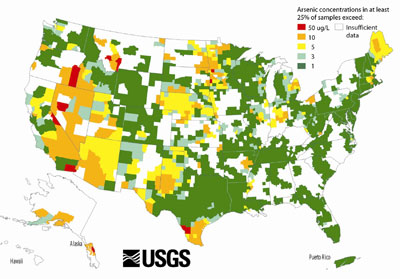Well water contaminated by natural sources such as bedrock containing arsenic has been reported to be the cause of arsenic toxicity throughout the world. Arsenic in drinking-water has attracted much attention since recognition in the 1990s of its wide occurrence in well-water in Bangladesh [WHO 2001].
| Table 2. Countries where arsenic toxicity has been reported from natural source contamination of well water [NRC 2000] |
|
|
|
|
|
|
|
|
|
|
|
|
|
|
|
|
|
|
|
|
Areas in the United States with the highest natural groundwater concentrations of arsenic are the Southwest, Northwest, Northeast, Alaska, and other areas near geothermal activity [ATSDR 2007].
The form of ingested arsenic from drinking water sources will vary according to its exposure to air. Deep wells contain predominantly arsenite (arsenic III) and surface water will contain predominantly arsenate (arsenic V) [Rossman 2007].
Figure 1: U.S. Geological Survey Map of Arsenic in Groundwater

(for larger view, click on image)
United States Geological Survey map of areas of the United States with arsenic in groundwater samples exceeding the specified levels in 25% or more of samples tested [USGS 2005].
Groundwater may also contain elevated concentrations of arsenic from:
- agricultural runoff,
- contamination from runoff from wood preservatives containing arsenic,
- improperly disposed arsenical chemicals, or
- mining [Rossman 2007].
Instances of drinking water contamination by manmade sources has been documented at sites in the following countries:
- Brazil,
- Chile,
- India,
- Mexico
- Nicaragua, and
- Thailand [IARC 2004].
In certain areas of the West, Midwest, Southwest, and Northeastern United States, well water may contain levels greater than 50 micrograms per liter ( or 50 ppb) [Rossman 2007].
The EPA maximum contaminant level for arsenic in drinking water is 10 ppb [ATSDR 2007].
The U.S. Geological Survey has mapped arsenic distribution in soils in the United States. For the Conterminous United States, the geometric mean arsenic level in soil is 5.2 parts per million (ppm). Soil levels in the Eastern United States (east of the 96th meridian) have a geometric mean of 4.8 ppm arsenic (range <0.1 to 73 ppm). The Western United States (west of the 96th meridian) levels have a geometric mean of 5.5 ppm arsenic (range <0.10 to 97 ppm). [Shacklette and Boerngen 1984].
Elevated levels of arsenic in soil (due to either natural or man-made contamination) may be an ingestion risk, especially for children with pica and mouthing behaviors during play [Rossman 2007]. However, the bioavailability of arsenic in soil is variable, and dependent on the chemical form of arsenic.
Arsenic uptake in plants does not appear to reach levels dangerous to human health [Rossman 2007].
Inhalation exposure to coal fly ash may occur in some countries when coal that is contaminated with high levels of arsenic is burned [Rossman 2007].
|



